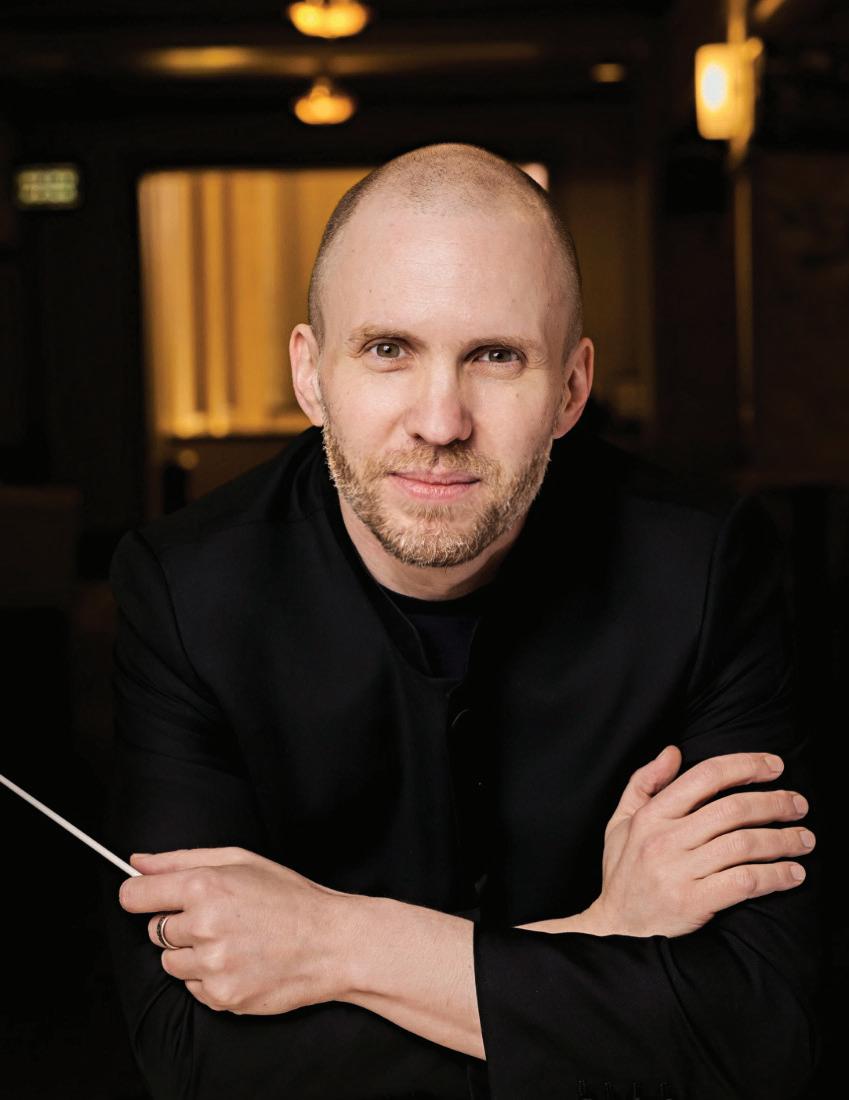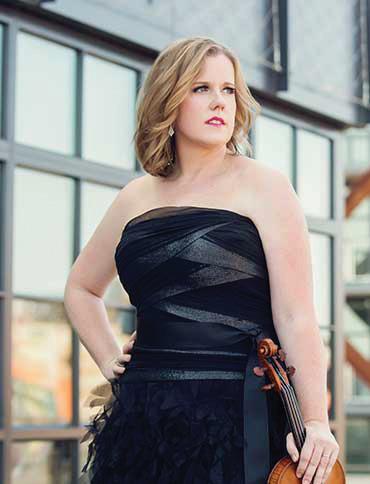SYMPHONY NO. 8
MARCH 20, 2025 / 7:30 PM / THE NOORDA AT UVU
MARCH 20, 2025 / 10:00 AM / MAURICE ABRAVANEL HALL (FINISHING TOUCHES)
MARCH 21, 2025 / 7:30 PM / MAURICE ABRAVANEL HALL
MARCH 22, 2025 / 7:30 PM / MAURICE ABRAVANEL HALL
DAVID DANZMAYR , conductor
MADELINE ADKINS , violin
JESSIE MONTGOMERY
GLAZUNOV
RACHMANINOFF
DVOŘÁK
Overture
Concerto in A minor for Violin and Orchestra, Opus 82
Moderato - Andante sostenuto - Allegro
Vocalise
INTERMISSION
Symphony No. 8 in G major, Opus 88
I. Allegro con brio
II. Adagio
III. Allegretto grazioso
IV. Allegro ma non troppo

CONDUCTOR SPONSOR


GUEST ARTIST SPONSOR

David Danzmayr
Conductor
Described by ‘The Herald’ as “extremely good, concise, clear, incisive and expressive” David Danzmayr is widely regarded as one of the most exciting European conductors of his generation.
Danzmayr is in his second season as Music Director of the Oregon Symphony, having started his tenure there in the orchestra´s 125th anniversary season. He also stands at the helm of the versatile ProMusica Chamber Orchestra Columbus, an innovative orchestra comprised of musicians from all over the USA.
In addition he holds the title of Honorary Conductor of the Zagreb Philharmonic Orchestra with whom he had served as Chief Conductor—leading the Zagreb musicians on several European tours with concerts in the Salzburg Festival Hall, where they performed the prestigious New Year´s concert, and the Vienna Musikverein.
David has won prizes at some of the world´s most prestigious conducting competitions including at the International Gustav Mahler Conducting Competition and at the International Malko Conducting Competition. In recognition of his successes he has been awarded the Bernhard Paumgartner Medal by the Internationale Stiftung Mozarteum.
Madeline Adkins Violin
Madeline Adkins joined the Utah Symphony/Utah Opera as Concertmaster in 2016. She served as Associate Concertmaster of the Baltimore Symphony Orchestra from 2005-2016.
She performs on the “ex-Chardon” Guadagnini of 1782, graciously loaned by Gabrielle Israelievitch to perpetuate the legacy of her late husband, former Toronto Symphony concertmaster, Jacques Israelievitch
Adkins is a Concertmaster of the Grand Teton Music Festival and has served as Guest Concertmaster of the orchestras of Pittsburgh, Cincinnati, São Paulo, Houston, and Hong Kong, among many others. A sought-after soloist, Adkins has appeared with orchestras in Europe, Asia, Africa, and 26 US states. Her recording of the complete works for violin and piano by Felix Mendelssohn was released to critical acclaim in 2016.
As an educator, Adkins has coached the National Youth Orchestra at Carnegie Hall, the National Orchestral Insitute and the Haitian Orchestra Institute. She completed her studies at the New England Conservatory and the University of North Texas. When not on stage, Adkins is passionate about animal rescue, and has fostered over 100 kittens!
By Jeff Counts
Overture
Duration: 6 minutes.
THE COMPOSER – JESSIE MONTGOMERY (b. 1981)
–Many contemporary orchestral composers have “moments”, rising briefly and brightly before succumbing to the increasingly risk-averse nature of today’s symphonic music industry. But a select few have managed to break through and see their names stick in the annual rotation repertoire. Jessie Montgomery is firmly in the latter category. According to her impressive biography, Montgomery’s work “interweaves classical music with elements of vernacular music, improvisation, poetry and social consciousness, making her an acute interpreter of twenty-first century American sound and experience.” She is a world-wide phenomenon now, with too many honors to name. Among them was a three-year appointment in 2021 as the Chicago Symphony Orchestra’s Mead Composer-InResidence.
THE HISTORY – As part of her role with the CSO, Montgomery wrote three new orchestral works and two chamber music pieces. She also curated the highly acclaimed MusicNOW series, an event concept designed to promote thoughtful contemporary music experiences and provide direct access to composers and performers. Premiered by her Chicago Symphony colleagues in 2022 on a MusicNOW program (but not commissioned by them) was the brief but thrilling Overture. Montgomery’s program note for the piece (also brief and thrilling) states: “Overture is a one-movement orchestral tutti steeped in the harmonic textures inspired by a fusion between jazz and American classical idioms, Baroque rhythmic gestures, and polyphonic tension.” Subsequent performances were quick to follow, with a notable reading given by the Chicago Youth Symphony Orchestra in November of the same year. It was a fitting collaboration and a tribute to an influential artistic ambassador for the city, given Montgomery’s important work with Chicago-area high school students for the CSO’s Young Composers Initiative. Overture begins with a chantlike rhythmic cohesion but does not maintain it for long. About halfway through, the underlying harmonic tensions break up the metrical conformity and take the listener on a sonic (and visual) tour of the orchestra’s color palette.
THE WORLD – Elsewhere in 2022, Russia invaded Ukraine, Roe vs. Wade was overturned, the world’s oldest DNA samples were discovered in Greenland, Queen Elizabeth died and protests erupted in Iran over the killing of Mahsa Amini.
THE CONNECTION – These concerts represent the Utah Symphony premiere of Jessie Montgomery’s Overture
Violin Concerto in A Minor, Op. 82
Duration: 21 minutes in three movements (played without pause).
THE COMPOSER – ALEXANDER GLAZUNOV (18651936) – Glazunov’s name is mentioned in biographies with the usual trio of professional designations – composer, conductor, educator – but he was not equally gifted in each. As a composer, he showed very early promise and began writing his own music at the age of 11. He was studying soon after with Rimsky-Korsakov, who eventually saw a peer in the younger man, not a pupil. Glazunov’s academic credentials were just as sound, with the prestigious Directorship of the St. Petersburg Conservatory coming in 1905. It was only conducting that seemed to consistently elude Glazunov, and no amount of enthusiasm for the craft ever made him successful with it. Still, he did enjoy leading his own premieres when he could.
THE HISTORY – One such occasion was the first performance of his Violin Concerto in 1904. It was written for his Conservatory colleague Leopold Auer. The work is emblematic of a strange moment in the career of Glazunov. He was at the height of his creative confidence in 1904 and widely recognized as a potential successor to the Russian “Mighty Five” of Cui, Balakirev, Tchaikovsky, Mussorgsky and Rimsky-Korsakov. But he was also buffeted by the winds of modernism coming at him from the West. Glazunov was as hopeless a Romantic as ever there was, and he surely felt that time might be running out for conservative musical traditionalists like himself. His compositional productivity slowed significantly after 1906, never to be regained, as his anachronistic tastes continued to isolate him. The Concerto then, in the context of this crossroads, is fascinating. The response to the premiere was mixed, thanks to the work’s atypical construction and tone. Late 19th century concertos were extroverted, Olympic-level athletic affairs, with distinct movements and a clear division of labor between soloist and ensemble. Glazunov’s concerto was opposite to all these expectations. It proceeds through its movements without pause. It denies the soloist a cadenza until the very end. It embraces lyricism over technical showmanship. It employs a collaborative relationship between the violin and the orchestra instead of an oppositional one. What a courageous and decidedly non-conservative risk for
someone who felt the world passing him by to take. Glazunov initially wondered if he might be on the wrong track. “This work has caused me a lot of grief,” he wrote to Rimsky-Korsakov, “sometimes it seems to me that the music is rubbish.” It wasn’t, and it isn’t. The Violin Concerto, though seldom heard these days, had its moment in the sun with widespread recognition through the first decades of the 20th century.
THE WORLD – Elsewhere in 1904, the Anglo-Tibetan Treaty was signed, the stage play Peter Pan debuted in London and the Herero people of South-West Africa staged an uprising against German colonial rule.
THE CONNECTION – Utah Symphony has not programmed Glazunov’s Violin Concerto since the 2006–07 season. David Cho conducted and Ralph Matson was soloist.
Vocalise, Op. 34, No. 14
Duration: 6 minutes.
THE COMPOSER – SERGEI RACHMANINOFF (18731943) – That Rachmaninoff is remembered best today as a virtuoso pianist and a composer of multiple evergreen masterpieces for his chosen instrument is perhaps no surprise. The concertos. The études. The Preludes. These would be load-bearing columns for any legacy. But they are only part of Rachmaninoff’s history. He was gifted with one of the purest melodic souls of his or any time, and he also used it to create stunning orchestral scores (including the symphonies, Isle of the Dead and Symphonic Dances) and a surprising amount of vocal music. In addition to six operas (some completed, some only planned, all sadly forgotten now), Rachmaninoff wrote several choral works and some 80 songs for solo voice.
THE HISTORY – 13 of the 14 lieder that make up the Op. 34 set of songs were written in 1912, but the final number was complete three years later in 1915. As the closing part of the set, No. 14 (Vocalise) stands out at first glance for the wordlessness that fueled its eventual ubiquity. In fact, it has been argued that the entirety of Rachmaninoff’s gorgeous and lengthy song catalogue would be a standard part of the repertory if not for their Russian language, and the popularity of the culturally neutral Vocalise seems to prove it. Rachmaninoff wrote the song for the star coloratura soprano Antonia Nezhdanova of the Moscow Grand Opera. She initially balked at the lack of text, but the composer
convinced her that, in her capable care, the music required no such context and that the single syllable of “Ah” was enough. “What need is there of words,” he asked her, “when you will be able to convey everything better and more expressively…by your voice”. That smart bit of flattery settled matters and the 1916 premiere was very well received. By then, Rachmaninoff had already converted the piano accompaniment into an orchestral score to be conducted by Serge Koussevitzky. Koussevitzky’s connection to the Vocalise goes even further. Thanks to some recent scholarship on the publication history of the song, we now know that the famed maestro (a good friend to the composer and virtuoso string instrumentalist in his own right) performed the Vocalise previously in December of 1915 on the double bass! No recording of that night exists, unfortunately, so it must remain the stuff of letters and legend. We can still enjoy the prophecy of that event, however, as Koussevitzky’s rendition predicted the countless arrangements, for nearly every instrument imaginable, that have come since. Rachmaninoff’s own orchestral version (without soloist) was penned right after the official premiere.
THE WORLD – Elsewhere in 1915, war raged across Europe, but it was also a year of great art in every discipline. Kafka published his masterpiece The Metamorphosis, Picasso produced his oil on canvas Harlequin and Sibelius premiered his 5th Symphony.
THE CONNECTION – Utah Symphony last performed Rachmaninoff’s Vocalise in 2022 with Eivind Gullberg Jensen on the podium.
Symphony No. 8 in G Major, op. 88
Duration: 34 minutes in four movements.
THE COMPOSER – ANTONÍN DVOŘÁK (1841-1904) –Dvořák produced a lot of excellent music in 1889, immediately following a period of focus on the revision of earlier works (a practice that plagued the chronological understanding of his catalogue for many years). Among the fresh creations were three overtures, the “Dumky” Trio, the Requiem and the 8th Symphony. He was truly then living up to the promise identified by Brahms over a decade earlier. Dvořák was still a few years away from his American academic residency and the creation of his most internationally beloved work (Symphony No. 9), but his fame as a composer in 1889 was established enough that when the Prague Conservatory offered him a teaching post, he declined.

THE HISTORY – The job was offered again a year later and Dvořák accepted. Biographer Klaus Döge believed this reversal was due in part to the falling out Dvořák had with Simrock (his publisher) over the fee offered for the 8th Symphony. Their relationship had almost broken over the 7th Symphony fee so when Simrock offered two thirds less for the 8th, Dvořák took even deeper offense. He was a driven composer, insistent on making a highly original impression as a symphonist and Simrock’s continual undervaluing of his most cherished efforts put significant strain on their professional relationship. Dvořák’s consequent willingness to take his work to a competing firm in London was also a prime contributor to the numbering issues that surrounded his symphonies for decades. Novello published this work as No. 4, not 8, but the difference doesn’t mean much anymore. Despite Novello’s desire to maintain a distinct collection of their own, the G Major Symphony was Dvořák’s 8th foray into the form and we call it so today for good reason. It signaled the fully realized maturity of a composer intent on finally leaving his Germanic influences behind, and we should not forget the work it took on Symphonies 1-7 for him to get there. Dvořák scholar Otakar Sourek felt the 8th Symphony projected the composer’s Slavic heritage “more completely…than any of his other symphonies” and he further declared that the “variety of mood and emotional eruptiveness” of the music wonderfully captured Dvořák’s “human and artistic personality.” The symphony was mostly written in the Bohemian countryside that Dvořák so adored and finished in Prague late in 1889. Dvořák conducted the 1890 premiere in celebration of his election to the Bohemian Academy of Science, Literature and Arts. He believed he had at last made something “different from other symphonies.” By this he meant anyone’s, not just his own.
THE WORLD – Elsewhere in 1889, the Eiffel Tower was erected as part of the World’s Fair in Paris, Vincent Van Gogh painted The Starry Night, the Wall Street Journal was founded and Brazil became a Republic.
THE CONNECTION – Dvorak’s 8th last appeared on a Utah Symphony program back in 2022. Thierry Fischer was conducting.
